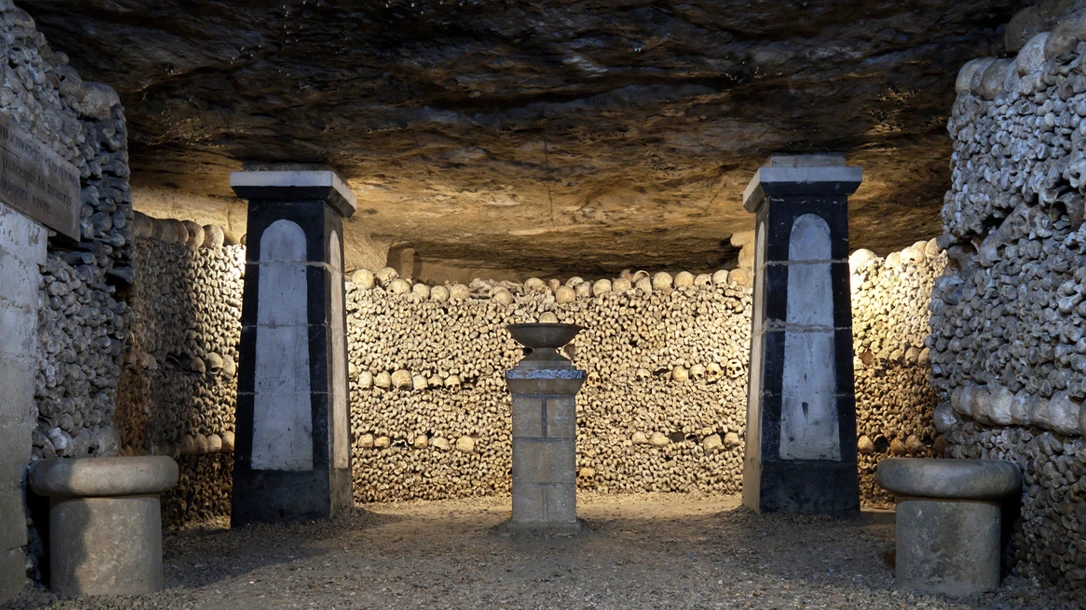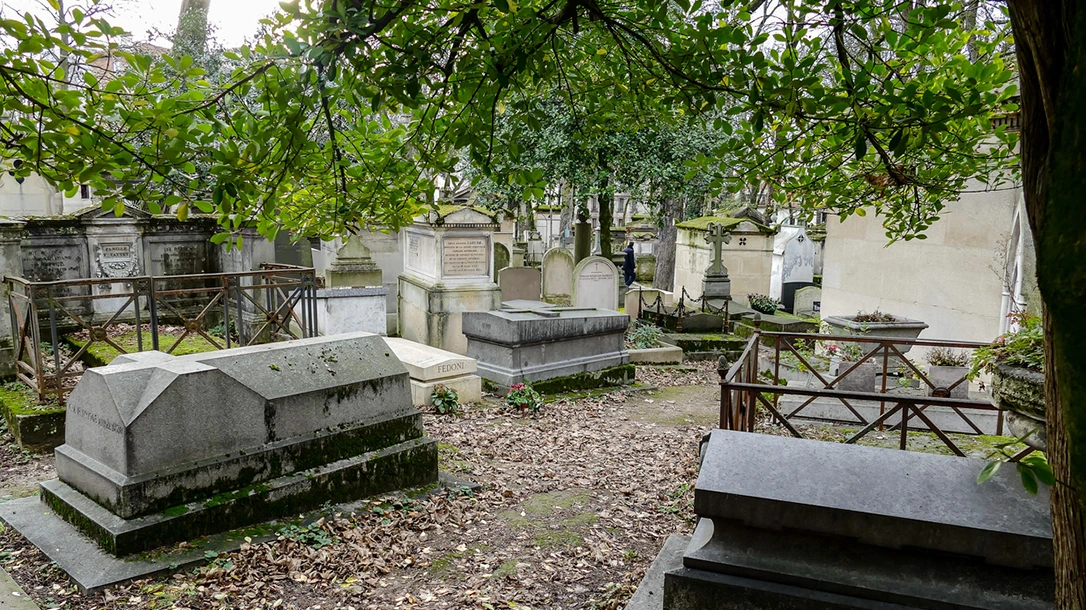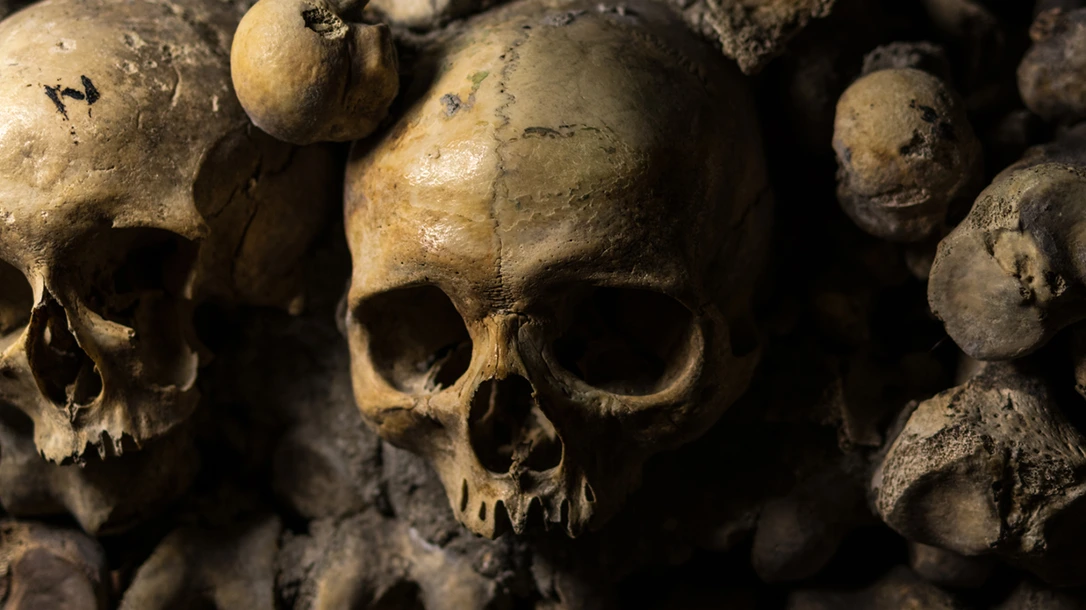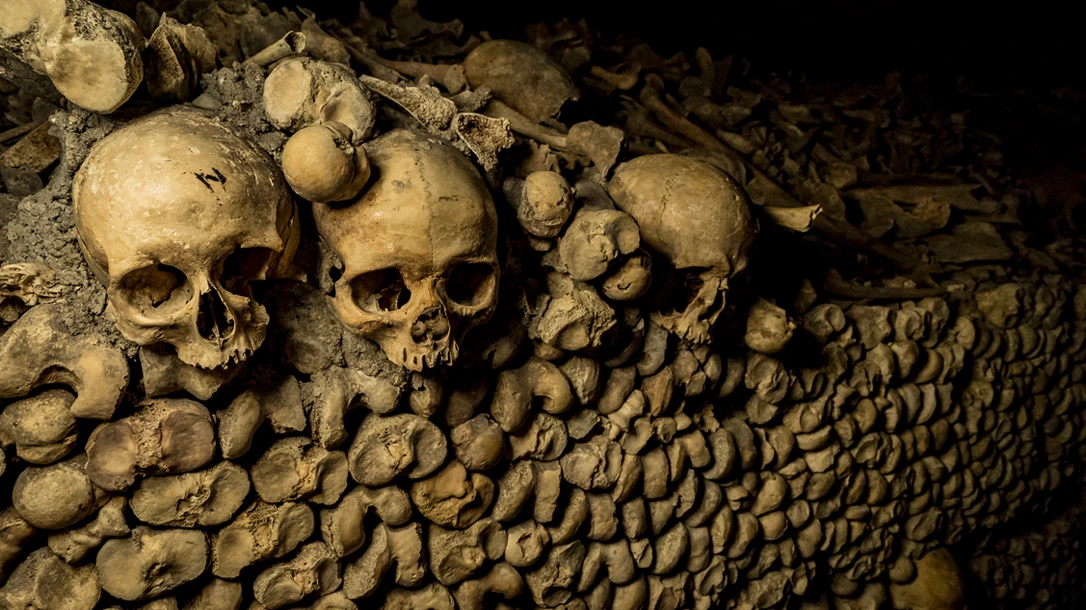Beneath the romantic streets of Paris lies a shadowy underworld, a vast, intricate network of tunnels known as the Catacombs of Paris. Stretching for miles beneath the bustling city, these underground ossuaries house the skeletal remains of more than six million people, carefully arranged in haunting displays of skulls and bones.
Originally created to address the dire overcrowding of Parisian cemeteries in the 18th century, the catacombs evolved into a place where architecture, history, and mortality converge. Today, they stand as one of the most macabre and fascinating destinations in all of Europe, drawing tourists, historians, and philosophers alike.
The Catacombs of Paris are more than just a curiosity; they are a chilling yet poignant testament to the city’s layered past, its struggles with death and disease, and its ongoing evolution through the centuries.
Advertisement — Continue Reading Below

The Origins of the Catacombs
The story of the Catacombs of Paris begins in the late 18th century. Paris was growing rapidly, and so were its cemeteries. Overcrowded and unsanitary graveyards, especially the notorious Les Innocents Cemetery, became a public health hazard. Authorities made the drastic decision to relocate millions of remains to the city’s underground quarry tunnels, which had been mined for limestone since Roman times.
From 1786 to 1814, bones were moved under the cover of darkness in solemn, candle-lit processions. The bones were deposited in the tunnels, transforming these ancient stone pathways into the ossuary we now know. The workers, known as ‘les carriers,’ meticulously arranged skulls and femurs in artistic displays, turning a necessity into a somber kind of art. These underground galleries are now lined with bone walls that stretch for miles.
Advertisement — Continue Reading Below
The process of converting these quarries into a structured ossuary was not merely logistical; it was symbolic. City officials, led by Charles-Axel Guillaumot, the first Inspector General of Quarries, oversaw the early organization and reinforcement of the tunnels to prevent cave-ins and ensure safe passage. Over time, the ossuary took on a more intentional and artistic form.
Bones were not simply dumped into the catacombs but were carefully categorized and stacked, often accompanied by plaques bearing religious or philosophical inscriptions. These additions reflected a desire to not only solve a public health crisis but also to memorialize the dead with dignity. As the catacombs expanded, they began to serve not just as a mass grave but as a public statement, a memento mori reminding future generations of the inevitable reality of death and the deep history that lies beneath Paris.

Advertisement — Continue Reading Below
Architecture and Historical Significance
The Catacombs of Paris span over 200 miles of tunnels, although only a small portion is open to the public. Within these tunnels, signs guide visitors through dimly lit paths, past arches, pillars, and alcoves filled with skeletal remains. One of the most famous inscriptions at the entrance reads: “Arrête, c’est ici l’empire de la Mort,” which translates to “Stop, this is the empire of Death.” The ossuary’s architecture is both haunting and beautiful, a silent echo of Paris’s past.
Beyond being a burial site, the Catacombs of Paris have served many roles throughout history. During World War II, the underground tunnels were used by the French Resistance as a hiding place and strategic route. Conversely, Nazi forces also used them to establish bunkers. Over the centuries, the catacombs have fascinated philosophers, poets, and scientists alike. Their existence forces a reflection on mortality, art, and the fleeting nature of life.
The layout of the catacombs reflects both practical engineering and symbolic design. Narrow corridors twist and descend into chambers known as “rotundas,” “sacs,” and “crypts,” some of which bear names honoring saints or notable figures. The temperature remains a steady 14°C (57°F), and the damp, echoing atmosphere enhances the sense of solemnity and isolation. In some sections, the bones are arranged into crosses, hearts, or columns, revealing a surprising artistic intention behind the macabre displays.
Advertisement — Continue Reading Below
These designs were not merely decorative; they were meant to inspire contemplation, humility, and reverence. Hidden among the ossuary’s galleries are also historic markers, such as old street names etched into the stone, remnants of the original quarry mapping system. Together, these details transform the catacombs from a functional burial site into a deeply symbolic space, an underground cathedral of death preserving the memory of millions beneath the foundations of Paris.
Modern Tourism and Preservation
Today, the Catacombs of Paris attract nearly 500,000 visitors each year. Access is tightly controlled to preserve the delicate bones and structure. Though tourists see only a mile of the ossuary, it leaves a lasting impression. Photography is allowed, but touching the bones or deviating from the path is strictly prohibited. Unauthorized explorers, known as ‘cataphiles,’ illegally navigate hidden sections of the tunnels, documenting graffiti, secret rooms, and even underground parties. Efforts to map and protect the catacombs continue today.
To visit the Catacombs of Paris, tourists can take the Paris Métro and disembark at Denfert-Rochereau Station (Lines 4 or 6), which is located directly across from the entrance. The official entrance is at 1 Avenue du Colonel Henri Rol-Tanguy, in the 14th arrondissement. Visitors descend approximately 130 steps to enter the catacombs and climb a similar number to exit.
Advertisement — Continue Reading Below

The Price of Admission
Tickets can be purchased online in advance, which is highly recommended due to limited daily entries. As of 2025, general admission tickets are €29 (around USD 32) for adults, with reduced rates for students, children, and EU citizens. Guided tours, which provide deeper historical insight and access to restricted areas, are available for an additional fee.
The iconic stone staircases that lead visitors down into the Catacombs of Paris were carefully constructed to provide safe and stable access to the deep underground galleries. Built in the late 18th century during the initial conversion of the limestone quarries into an ossuary, these stairways had to withstand constant foot traffic while navigating the uneven terrain of the tunnels. Crafted from local limestone extracted during quarrying, the stairs are sturdy and functional, blending seamlessly with the natural stone surroundings.
Advertisement — Continue Reading Below
Their spiral design not only conserves space within the narrow entrance shafts but also adds to the eerie atmosphere, as visitors descend step by step into the dimly lit depths below the bustling city streets. Over centuries, the stairs have been maintained and reinforced to ensure visitor safety while preserving the historical authenticity of this haunting subterranean world.
A Final Resting Place
The Catacombs of Paris remain one of the world’s most unique, mysterious, and unsettling tourist destinations. Far more than just a collection of bones, they are a sprawling underground labyrinth that tells the story of a city grappling with its past—one skull, femur, and inscription at a time.
These eerie corridors are a testament to human ingenuity, mortality, and history, revealing how necessity, art, and reverence for the dead converged beneath the streets of a thriving metropolis. Within these shadowy passageways, centuries of life and death are preserved in stone and bone, offering a rare and haunting perspective on how Parisians have managed space, memory, and identity through time.
Advertisement — Continue Reading Below
The Catacombs are a place where art and death meet, where silence speaks volumes, and where the line between the living and the departed seems to blur. Whether you’re drawn by curiosity, a fascination with the macabre, or a desire to understand a deeper layer of Parisian history, walking through the underground halls of bones offers an unforgettable and sobering glimpse into the city’s hidden and shadowy legacy.

















